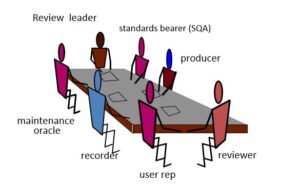What Are Reviews?
- a meeting conducted by technical people for technical people
- a technical assessment of a work product created during the software engineering process
- a software quality assurance mechanism
- Serves as a training ground for junior software engineers to observe different approaches to software analysis, design, and construction
Purpose of Reviews
- Include the formal technical review (also called a walkthrough or inspection)
–Acts as the most effective SQA filter
–Conducted by software engineers for software engineers
–Effectively uncovers errors and improves software quality
–Has been shown to be up to 75% effective in uncovering design flaws
- Require the software engineers to expend time and effort, and the organization to cover the costs
Formal Technical Review (FTR)
- Objectives
–To uncover errors in function, logic, or implementation for any representation of the software
–To verify that the software under review meets its requirements
–To ensure that the software has been represented according to predefined standards
–To make projects more manageable
The Players

Conducting the Review

The FTR Meeting
- Has the following constraints
–From 3-5 people should be involved
–
–Advance preparation (i.e., reading) should occur for each participant but should require no more than two hours a piece and involve only a small subset of components
–
–The duration of the meeting should be less than two hours
–
- Focuses on a specific work product (a software requirements specification, a detailed design, a source code listing)
- Activities before the meeting
–The producer informs the project manager that a work product is complete and ready for review
–
–The project manager contacts a review leader, who evaluates the product for readiness, generates copies of product materials, and distributes them to the reviewers for advance preparation
–
–Each reviewer spends one to two hours reviewing the product and making notes before the actual review meeting
–
–The review leader establishes an agenda for the review meeting and schedules the time and location
- Activities during the meeting
–The meeting is attended by the review leader, all reviewers, and the producer
–
–One of the reviewers also serves as the recorder for all issues and decisions concerning the product
–
–After a brief introduction by the review leader, the producer proceeds to “walk through” the work product while reviewers ask questions and raise issues
–
–The recorder notes any valid problems or errors that are discovered; no time or effort is spent in this meeting to solve any of these problems or errors
–
The FTR Meeting
- Activities at the conclusion of the meeting
–All attendees must decide whether to
- Accept the product without further modification
- Reject the product due to severe errors (After these errors are corrected, another review will then occur)
- Accept the product provisionally (Minor errors need to be corrected but no additional review is required)
–All attendees then complete a sign-off in which they indicate that they took part in the review and that they concur with the findings
- Activities following the meeting
–The recorder produces a list of review issues that
–
- Identifies problem areas within the product
- Serves as an action item checklist to guide the producer in making corrections
–The recorder includes the list in an FTR summary report
- This one to two-page report describes what was reviewed, who reviewed it, and what were the findings and conclusions
–The review leader follows up on the findings to ensure that the producer makes the requested corrections

